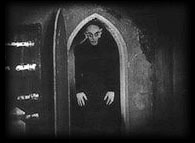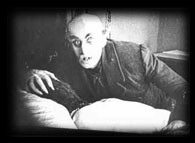|
More about Nosferatu
Murnau made several
departures from the Stoker novel in creating his silent classic. The
vampire has a distinctly reptilian appearance (in another era, he would
look like a B-movie alien), he is called Count Orlock, the setting is
Baltic, and the hero is female - Nina, initially the Count's prey, who
at the end turns predator to destroy him.

The vampire is
portrayed by Max Schreck and the film opens with Orlock renting a home
in Brennen and then killing the land agent, Jonathan (Gustav Von Wangerheim),
after meeting his beautiful fiancee, Nina (Greta Schroeder). Later he
travels aboard a cargo ship with a shipment of coffins to take up his
lease. When the ship docks in Brennen with its dead crew, the populace
fear and earthly plague rather than a supernatural one, but Nina suspects
the truth. No longer the virginal bride she was when she first me Orlock,
she now knows the darker side of sexuality and uses it to ensnare him
- in her room as the rising sun engulfs it with light.

Nosferatu is a
masterpiece of the first great horror school of German cinema. In its
time it was a technical benchmark - packed with tricks and special effects,
such as slow motion and blurred photography to give the vampire a supernatural
existence, and negative printing to add an eerie, uncanny atmosphere.
Although the acting appears stilted and crude by todays standards, it
is much more mature than its Hollywood equivilant at the time. The subject
matter, too, is complex and subtle - it may have been filmed in monochrome,
but its concept is hardly black and white.
Shortly after Nosferatu
was premiered in 1922, Florence Stoker (Bram's widow) sued Murnau for
breack of copyright, allegng the film was an unauthorised version of
Dracula. The cuort agreed and ordered the film to be destroyed, but
some prints did survive and, riding high on later successes, Murnau
eventually re-released the film in the United States in 1929.


More
about
Pandora's Box by GW Pabst
Metropolis by Fritz Lang
The Cabinet of Dr Caligari by Carl Mayer & Hans Janowitz
Seigried by Fritz Lang
|